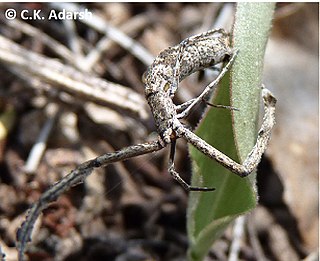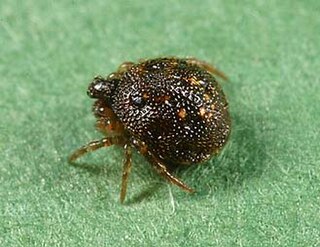
Theridiidae, also known as the tangle-web spiders, cobweb spiders and comb-footed spiders, is a large family of araneomorph spiders first described by Carl Jakob Sundevall in 1833. This diverse, globally distributed family includes over 3,000 species in 124 genera, and is the most common arthropod found in human dwellings throughout the world.

Tapena is a monotypic genus of butterflies in the family Hesperiidae subfamily Pyrginae. Its single species is Tapena thwaitesi, the black angle, found in Indomalayan realm. The species was described by Frederic Moore in 1881 and is named after George Henry Kendrick Thwaites, the director of the botanical garden at Peradeniya, Sri Lanka between 1849 and 1880.

Spiders are air-breathing arthropods that have eight legs, chelicerae with fangs generally able to inject venom, and spinnerets that extrude silk. They are the largest order of arachnids and rank seventh in total species diversity among all orders of organisms. Spiders are found worldwide on every continent except for Antarctica, and have become established in nearly every habitat with the exceptions of air and sea colonization. As of July 2019, at least 48,200 spider species, and 120 families have been recorded by taxonomists. However, there has been dissension within the scientific community as to how all these families should be classified, as evidenced by the over 20 different classifications that have been proposed since 1900.
George Henry Kendrick Thwaites was an English botanist and entomologist.
Isometrus thwaitesi is a species of scorpion in the family Buthidae.
Thwaites's skink, also known commonly as the fourtoe snakeskink and chaturanguli sarpahikanala in Sinhalese, is a species of skink, a lizard in the family Scincidae. The species is endemic to the island of Sri Lanka.

Miagrammopes is a genus of cribellate orb weavers first described by Octavius Pickard-Cambridge in 1870. These spiders have a unique shape and only four of their original eight eyes. They spin a single line of web, actively watching and jerking the line to catch their prey.
Miagrammopes thwaitesii, is a species of spider of the genus Miagrammopes. It is native to India and Sri Lanka.
Phoroncidia nasuta, is a species of spider of the genus Phoroncidia. It is found in Japan, Sri Lanka and Taiwan. The spider is known as Hana Naga poke Ne spider (トウキョウカブトヒメグモ) in Japan.

Phoroncidia is a genus of comb-footed spiders that was first described by J. O. Westwood in 1835.
Phoroncidia septemaculeata, is a species of spider of the genus Phoroncidia. It is found in Sri Lanka and India.
Phoroncidia testudo, is a species of spider of the genus Phoroncidia. It is native to India and Sri Lanka.
Brunepisinus is a monotypic genus of comb-footed spiders containing the single species, Brunepisinus selirong. It was first described by H. Yoshida & J. K. H. Koh in 2011, and is found on Borneo.
Phoroncidia americana is a species of cobweb spider in the family Theridiidae. It is found in the United States, Canada, Cuba, and Jamaica.
Gasteracantha flava is a species of spider described in 1849 from Chile. The spider's abdomen bears 14 spines and is yellow in color with brown or black sigilla and a strongly wrinkled ventral side. The World Spider Catalog currently treats this taxon as a spiny orb-weaver spider in the genus Gasteracantha. In 1849, H. Nicolet included it in the genus Gasteracantha along with 18 other species he described from Chile. Nicolet described G. flava as being closely allied to another species described at the same time, Gasteracantha spissa, which had the same number and shape of spines and was very similar. Subsequent authors refined Nicolet's species, and in a 1996 publication Herbert Levi wrote, "All Nicolet's species seem to belong in Phoroncidia (Theridiidae)." Levi transferred the 14-spined taxon spissa, described by Nicolet as very similar to G. flava, to the genus Phoroncidia, creating the new combination Phoroncidia spissa. However, Levi did not explicitly address G. flava, so it remains in Gasteracantha as of November 2019, though its purported sister species now belongs to Phoroncidia and no other Gasteracantha species has more than six spines.




